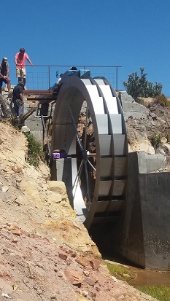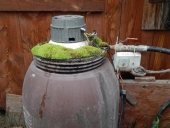
 2
2




 3
3




John Daley Bendigo, Australia The Enemy of progress is the hope of a perfect plan
Benefits of rainfall collection https://permies.com/t/88043/benefits-rainfall-collection
GOOD DEBT/ BAD DEBT https://permies.com/t/179218/mortgages-good-debt-bad-debt

 3
3




Failure is a sign of activity and learning. It had nothing to do with under achievement
I never want to have a team member who has never failed - They are not doing!! 👍
 2
2




John C Daley wrote:wow, its hard to comprehend you have got this far without the mechanicals sorted, well done.
All the info about the wheel can be done mathematically, I studied it at Civil Engineering school.
I cannot remember much, but the is a Hydro buff on this site, Thomas Rubino.
Hydro Engineers are the ones to help.
I will look around out of interest.
The head is 9m, Some questions;
- what type of wheel are you using, undershot, overshot or pelton?- efficiency
- What is the estimated flow rate?- determine power output
- What power output are you expecting? Kilowatts
- what is the ultimate use of the power, out of interest?
Once the expected power output is established, then a gearbox / generator can be obtained to match that output.
Photos would be nice, out of interest.
From; small town hydro power
Estimating power output
There is a simple equation you can use to estimate the power output for a system with 53 percent efficiency, which is representative of most small hydropower systems. Simply multiply net head (the
vertical distance available after subtracting losses from pipe friction) by flow (use U.S. gallons per minute) divided by 10.
That will give you the system’s output in watts (W).
The equation looks this: net head [(feet) x flow (gpm)]/10 = W.
IE approx 27 ft x 1000 us gal. x 0.1[ factor] = 2700 W. the flow rate is critical to the equation.
Hi John!
Thanks for the reply. We are a ground works company and have worked on a few projects in the past installing hydro, wind and some very large solar projects for others so we have some snippets of Knowledge!
We are aware that a normal turbine may be more efficient. However, this site with the lakes is out in front of my Father's house, and he is absolutely adamant he wanted a huge water wheel to look at going around for the rest of his days no matter what cost or efficiency implications it has! So here we are, building the biggest wheel we can for him! Of course we still want to generate the most electric we possibly can with the flow we have.
To answer your questions:
- what type of wheel are you using, undershot, overshot or pelton?- efficiency
We will be using a back shot or pitch back water wheel.
- What is the estimated flow rate?- determine power output
We have 150 liters per second we believe. Less in summer. But constant flow. We assume we will generate 10-15 horse power at a bit of a guess so far.
- What power output are you expecting? Kilowatts
I really have no idea yet!
- what is the ultimate use of the power, out of interest?
We have a farm here, with about 20 commercial industrial units, 5 houses and various stable blocks etc. We are hoping the electric we generate will contribute to our use.
I have attached a couple of PDF plans just for your interest. They are only basic and not 100% as built just yet. But close! And some pictures of our finished concrete wheel pit, It needs some landscaping in Spring! But we have just began a very wet winter period!
Thanks Brad
 3
3




Paul Fookes wrote:Welcome to Permies Brad.
Never wonder or worry that someone is more intelligent or clever than you. We each have a skill set that makes Permies a highly intelligent family.
I am a nurse who managed to build a house so we can all do what we want with help and support, which is what your Permies family does best - help and support.
BTW our house is compressed earth bricks and completely off the electricity grid.
I would love to see photos of your work in progress.
Cheers
















Failure is a sign of activity and learning. It had nothing to do with under achievement
I never want to have a team member who has never failed - They are not doing!! 👍
 3
3




John Daley Bendigo, Australia The Enemy of progress is the hope of a perfect plan
Benefits of rainfall collection https://permies.com/t/88043/benefits-rainfall-collection
GOOD DEBT/ BAD DEBT https://permies.com/t/179218/mortgages-good-debt-bad-debt
 2
2




John Daley Bendigo, Australia The Enemy of progress is the hope of a perfect plan
Benefits of rainfall collection https://permies.com/t/88043/benefits-rainfall-collection
GOOD DEBT/ BAD DEBT https://permies.com/t/179218/mortgages-good-debt-bad-debt
 3
3





|
Every plan is a little cooler if you have a blimp. And a tiny ad.
montana community seeking 20 people who are gardeners or want to be gardeners
https://permies.com/t/359868/montana-community-seeking-people-gardeners
|




